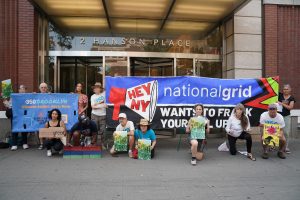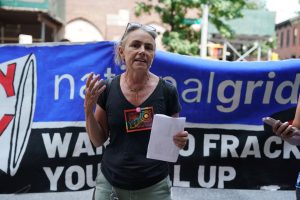
Protesters against the rate hike gathered in front of National Grid’s office at the Atlantic Terminal.
By Jean Brannum | jbrannum@queensledger.com
The Public Service Commission unanimously approved a rate increase for gas usage in the state on Aug 15, which will affect people in Brooklyn and parts of Queens. The PSC determined that the rate increases were necessary and consistent with Climate Leadership and Community Protection Act goals.
The three-year plan increases the average monthly gas bill by about $30 in the first year, nine dollars in the second year, and $22 in the third year, according to department staff who negotiated the terms of the rate plan. The new rate should increase National Grid’s annual capital to $833 million, $924 million, and $960 million. The new rate starts Sept 1.
Energy company National Grid, which provides electricity and gas in certain parts of New York State, but only provides gas in Kings County, proposed a rate hike in 2023 and with minor modifications was approved on Thursday. In a press release, National Grid said that the rate hike will fund infrastructure improvements, reduce emissions, and improve customer service. The company reasoned that the funding was necessary to ensure safe and reliable gas delivery in its service areas.
The approval process and proposal were met with opposition, primarily from environmental activism groups like Sane Energy Project, which has protested numerous times against National Grid. The nonprofit based in Williamsburg sports the slogan “We Won’t Pay to be Poisoned.” Leaders of the organization are pushing for New York to support more renewable energy projects and shut down National Grid’s Greenpoint Energy Center.
The majority of the 2100 public comments opposed the rate hike citing concerns about affordability, and investment in fossil fuels despite the passing of the CLCPA. The joint proposal includes steps to mitigate the impact of energy affordability, according to PSC Chair Rory Christian. National Grid already has an established program to help customers burdened by energy costs.
However, multiple labor unions and other businesses supported the increase citing that the extra cash would help National Grid meet its environmental goals and improve community safety.
In Albany at the PSC meeting, Sane Energy Project Director Kim Fraczek and other protesters stepped in front of the commission. Fraczek’s speech was mostly inaudible. The meeting was paused after Christian warned the group that they were disrupting the meeting.
“This is a testament that those who hold the power to protect us from predatory corporations defying environmental justice turn on the very people they are entrusted to protect,” Fraczek said in a statement. “The financial, health, and safety costs of the climate crisis are not considered in the equation, disregarding the demands of the people.”

Julia Salazar at the protest at the Atlantic Ave Terminal
Downstate at a National Grid office across the street from the Barclays Center on the same day, Sane Energy Project Director of Communications Priscilla Grim led a rally with State Senator Julia Salazar and members of 350 Brooklyn against the rate hike. Salazar accused National Grid of trying to generate more profits.
“They care about profits for their shareholders and do not care about our futures or our abilities as New Yorkers to make ends meet and pay our bills every month. It’s completely unsustainable,” Salazar said.
Assemblymember Emily Gallagher, who has spoken against National Grid multiple times, echoed Salazar’s comment in an X post.
“Once again we’re being forced to subsidize new fossil gas infrastructure and pad the profits of multinational utilities instead of rapidly transitioning to cleaner, cheaper, healthier renewables,” Gallagher said.
Agreement To Go Green?
Salazar touched on the Climate Leadership and Community Protection Act, which was signed into law in June 2019 and mandates the state reduce greenhouse gas emissions by 40% by 2030 and 85% by 2050.
Several environmental organizations including Sane and the Newtown Creek Alliance have spoken out about closing National Grid’s Greenpoint Energy Center, saying that the center causes pollution.
National Grid and the commission concluded that the energy center was necessary on peak usage days, but the commission recommended that the company close the center if alternative solutions are found.
Greenpoint resident Katherine Thompson said that funding fossil fuel infrastructure will delay the city’s progress towards CLCPA goals and that there should be more investment in green energy.

Greenpoint resident Katherine Thompson.
In the proposal, the PSC disagreed that investment in gas infrastructure would take away from CLCPA-related infrastructure, and even said that infrastructure funded by the rate increase was necessary to reach CLPCPA goals.
The Commission approved the new proposal with the agreement that the company would try to use alternative energy sources in the future.
One of the ways National Grid agreed to reduce its environmental impact is by adding additional renewable natural gas interconnections. Renewable natural gas (RNG) is fuel derived from natural waste that emits methane. The Newtown Creek Wastewater Treatment Plant produces RNG for National Grid but commenters said the project was incomplete, according to the joint proposal. The City reported in May that the system was offline 46% of the time from April 2023 to May 2024.
The RNG connects with existing gas lines called interconnection points. The joint proposal includes an agreement with National Grid that excess profits from RNG production will be refunded to customers. If the company does not profit from RNG, then the cost will be mostly recovered by shareholders. Another provision was that National Grid pursues non-pipeline alternatives.
In addition, National Grid agreed to cease gas marketing to encourage customers to use alternative energy sources and will provide information to new customers.
The environmental changes should reduce carbon dioxide emissions by an estimated 880,000 tons, according to an information presentation at the commission meeting.
Commissioners approved the proposal with the environmental provisions saying that the rate increase was necessary to provide safe and reliable energy to National Grid customers. However, Fraczek said the PSC is continuing to listen to corporations rather than find alternative energy solutions.
“Stop clinging to a law that favors industry, and instead follow a law that offers numerous options for releasing that grip,” Fraczek said. “The solutions are abundant. We just need leaders who are willing to lead.”
Officials from National Grid did not comment on the rate increase but did send press releases.


